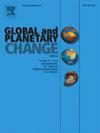北冰洋楚科奇海陆相有机碳的来源、运输、年龄和演化
IF 4
1区 地球科学
Q1 GEOGRAPHY, PHYSICAL
引用次数: 0
摘要
全球变暖和永久冻土融化预计将向北冰洋释放大量有机碳(OC),可能通过正反馈循环加剧气候变暖。通过碳同位素(13C和14C)和生物标志物(正构烷烃和木质素)分析,研究了北冰洋楚科奇海边缘陆相OC的来源、迁移和演化。研究结果表明,楚科奇大陆边缘海存在冰复体沉积(ICD)、表层土壤和高层植物等不同来源的恐怖oc。双碳同位素混合模型表明,ICD是沉积物中主要的碳- oc源(47±21%),其贡献从楚科奇陆架向斜坡逐渐增加。表层土壤oc的比例(18±7%)随距离和时间的增加而降低。在楚科奇陆架上富集的Δ14C值和较高的分子降解指标表明,大部分外源的terror - oc在到达沉积物-水界面之前已经发生了明显的降解。在迁移过程中,木质素和正烷烃的降解速度快于TOC,表层土壤oc的降解速度快于ICD-OC。这种长时间的运输可能加剧了选择性退化,因为在楚科奇陆架到斜坡的土壤碳含量变化比垂直沉积物岩心剖面更明显。本研究强调北冰洋是多种形式的恐怖OC的关键汇,并强调了OC埋藏过程中横向运输、沉积和降解的重要性。需要在精确的时间尺度上进一步研究,以澄清所观察到的空间差异是来自沉积物来源的变化,还是来自侧向搬运过程中水动力分选和选择性降解的综合影响。本文章由计算机程序翻译,如有差异,请以英文原文为准。
Sources, transport, age, and evolution of terrestrial organic carbon across the Chukchi Sea margin, Arctic Ocean
Global warming and permafrost thawing are expected to release substantial amounts of organic carbon (OC) into the Arctic Ocean, potentially intensifying climate warming through a positive feedback loop. In our study, we investigated the sources, transport, and evolution of terrestrial OC (terr-OC) across the Chukchi Sea margin in the Arctic Ocean, using carbon isotope (13C and 14C) and biomarker (n-alkanes and lignin) analyses. Our findings revealed that terr-OC from various sources, such as Ice Complex Deposits (ICD), topsoil, and high plants, was stored and evolved across the Chukchi continental marginal seas. A dual‑carbon-isotope mixing model indicated that ICD was the dominant terr-OC source (47 ± 21 %) in sediments, with its contribution increasing from the Chukchi shelf to the slope. While, the proportion of topsoil-OC (18 ± 7 %) decreased with distance and over time along the Chukchi slope. The enriched Δ14C values and higher molecular degradation proxies on the Chukchi shelf suggested that a large proportion of the exogenous terr-OC had undergone significant degradation before reaching the sediment-water interface. During transport, selective degradation occurred, with lignin and n-alkanes declining faster than TOC, and topsoil-OC degrading rapidly than ICD-OC. This prolonged transport likely intensified selective degradation, as changes in terr-OC across the Chukchi shelf to slope were more noticeable than in vertical sediment core profiles. This study emphasizes the Arctic Ocean as a critical sink for diverse forms of terr-OC and highlights the importance of lateral transport, deposition, and degradation in OC burial processes. Further research on precise temporal scales is needed to clarify whether the observed spatial differences stem from variations in sediment sources or from the combined effects of hydrodynamic sorting and selective degradation during lateral transport.
求助全文
通过发布文献求助,成功后即可免费获取论文全文。
去求助
来源期刊

Global and Planetary Change
地学天文-地球科学综合
CiteScore
7.40
自引率
10.30%
发文量
226
审稿时长
63 days
期刊介绍:
The objective of the journal Global and Planetary Change is to provide a multi-disciplinary overview of the processes taking place in the Earth System and involved in planetary change over time. The journal focuses on records of the past and current state of the earth system, and future scenarios , and their link to global environmental change. Regional or process-oriented studies are welcome if they discuss global implications. Topics include, but are not limited to, changes in the dynamics and composition of the atmosphere, oceans and cryosphere, as well as climate change, sea level variation, observations/modelling of Earth processes from deep to (near-)surface and their coupling, global ecology, biogeography and the resilience/thresholds in ecosystems.
Key criteria for the consideration of manuscripts are (a) the relevance for the global scientific community and/or (b) the wider implications for global scale problems, preferably combined with (c) having a significance beyond a single discipline. A clear focus on key processes associated with planetary scale change is strongly encouraged.
Manuscripts can be submitted as either research contributions or as a review article. Every effort should be made towards the presentation of research outcomes in an understandable way for a broad readership.
 求助内容:
求助内容: 应助结果提醒方式:
应助结果提醒方式:


